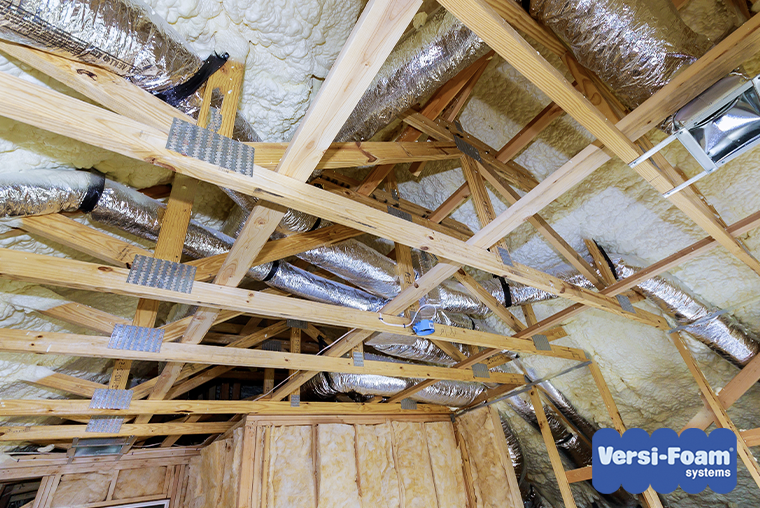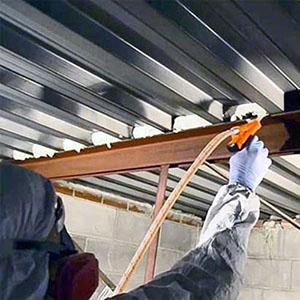Spray Foam: The Ultimate Option for Air Sealing and Insulation
Spray foam insulation has arised as a leading option for reliable air sealing and thermal insulation, using a distinct mix of buildings that set it apart from conventional methods. Recognizing the complete extent of its advantages, installation processes, and comparisons with other insulation kinds is crucial for making educated choices.
What Is Spray Foam?
Spray foam is a versatile insulation material that incorporates the principles of air securing and thermal resistance to enhance power performance in structures. Composed primarily of polyurethane or other similar compounds, spray foam is applied as a liquid that broadens upon call with surface areas, producing a solid, continual layer of insulation. This special residential or commercial property allows it to fill up voids, cracks, and spaces that typical insulation products may neglect, offering a premium air seal.
There are two main kinds of spray foam: open-cell and closed-cell. Open-cell spray foam is lighter and much more versatile, offering exceptional noise absorption and a lower R-value per inch - Spray Foam. On the other hand, closed-cell spray foam is denser, giving a higher R-value, wetness resistance, and included architectural honesty to constructing components
The application procedure commonly involves customized tools, ensuring a smooth application that sticks to various substratums, consisting of wood, steel, and concrete. This versatility makes spray foam ideal for both new constructions and retrofitting existing structures. Its capability to create an airtight barrier dramatically adds to lowering power usage and enhancing interior air high quality, therefore making it a favored selection amongst property owners and builders alike.
Benefits of Spray Foam Insulation
One of the most substantial advantages of spray foam insulation is its phenomenal capacity to create a constant air barrier, which successfully minimizes power loss. Unlike conventional insulation materials, spray foam expands to fill up spaces and cracks, making sure that air leak is considerably minimized. This particular not just boosts energy efficiency yet also results in decrease utility bills with time.
Furthermore, spray foam insulation gives premium thermal resistance, adding to a much more secure interior environment. Its high R-value per inch permits efficient insulation in constrained rooms, making it optimal for attic rooms, wall surfaces, and crawl areas. The moisture-resistant residential properties of spray foam assistance avoid mold and mildew and mildew development, promoting much healthier living conditions.
An additional vital advantage of spray foam insulation is its sound-dampening high qualities (Spray Foam). It efficiently reduces noise transmission in between spaces, producing a quieter and a lot more comfy home atmosphere. The longevity of spray foam also stands apart, as it does not droop or clear up in time, preserving its performance throughout its life expectancy
How Spray Foam Functions
Understanding just how spray foam insulation works is important for appreciating its performance in air sealing and thermal resistance. Spray foam insulation includes two key parts: isocyanate and polyol resin. When these elements are combined, they undergo a chemical reaction that triggers the product to expand quickly, producing a dense foam that fills up splits, spaces, and tooth cavities.
As the foam increases, it sticks to surface areas, developing an airtight seal that dramatically lowers air seepage. This characteristic makes spray foam insulation very reliable at preventing drafts and moisture penetration, which can bring about energy loss and damages with time. Furthermore, the closed-cell variation of spray foam offers superior thermal resistance as a result of its inflexible structure, successfully lessening warmth transfer.
The unique homes of spray foam enable it to satisfy uneven surfaces, making certain thorough insurance coverage and a smooth barrier. Consequently, spray foam insulation not only boosts energy efficiency however also adds to improved indoor air top quality by lowering the buildup of pollutants and allergens. Inevitably, understanding the mechanics behind spray foam emphasizes its role as a superior selection for insulation and air securing in both residential and commercial applications.
Installment Refine Review

Before installment, the area must be adequately cleaned up and prepped, guaranteeing that surface areas are totally free from debris, dust, and dampness. This step is crucial since contaminants can compromise attachment and overall efficiency. Once the area is prepared, the application involves mixing the two elements of the spray foam, which broadens upon contact and fills link up gaps properly.
Trained professionals need to carry out the setup, using customized tools to make sure uniform coverage and ideal thickness. Security safety measures, consisting of putting on protective gear and making certain proper ventilation, are crucial during this procedure. After application, the foam normally cures rapidly, creating a strong barrier that boosts power performance.
Contrasting Spray Foam to Typical Insulation
When reviewing insulation choices, spray foam insulation stands out in comparison to traditional products such as fiberglass and cellulose. Unlike fiberglass and cellulose, which can permit air seepage, spray foam expands upon application, filling view it spaces and crevices to create an airtight seal.
In addition, spray foam gives a greater R-value per inch than traditional insulation types, offering even more reliable thermal resistance in a thinner profile. This particular is specifically useful in spaces with restricted dental caries deepness. Moreover, spray foam is resistant to dampness and mold development, which can be a substantial interest in cellulose and fiberglass, particularly in humid settings.
However, spray foam insulation typically lugs a greater in advance cost than its conventional counterparts. House owners should evaluate this first financial investment versus long-lasting power cost savings and efficiency advantages. Inevitably, while both insulation types serve their function, spray foam emerges as an advanced option for modern insulation demands, especially in regards to air sealing and thermal performance.

Verdict
In summary, spray foam insulation stands for an extremely efficient option for attaining ideal air sealing and thermal resistance. Its unique residential properties, consisting of wetness resistance and sound dampening, make it ideal for numerous applications in both new constructions and retrofitting jobs (Spray Foam). Although the first prices might be higher compared to standard insulation materials, the lasting benefits, such as considerable power cost savings and boosted interior air top quality, justify the investment and underscore its worth in contemporary building practices.
Spray foam insulation has arised as a leading service for reliable air securing and thermal insulation, using an one-of-a-kind combination of properties that establish it apart from standard methods.Spray foam is a flexible insulation product that combines the principles of air sealing and thermal resistance to enhance power efficiency in structures.When evaluating insulation options, spray foam insulation stands out in contrast to traditional materials such as fiberglass and cellulose. Ultimately, while both insulation kinds offer their objective, spray foam emerges as an extra sophisticated option for contemporary insulation requirements, specifically in terms resource of air securing and thermal effectiveness.
In recap, spray foam insulation stands for a highly effective remedy for attaining optimal air securing and thermal resistance.
Comments on “Leading Applications of Spray Foam for Residential and Commercial Properties”